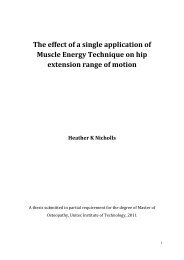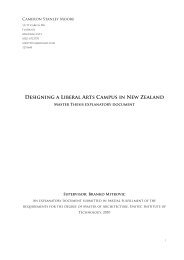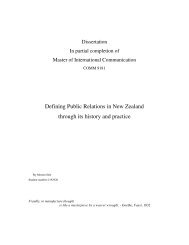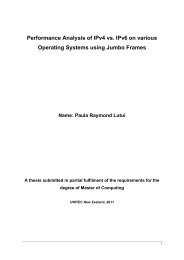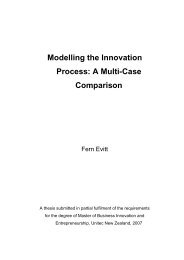The Study of Students Perceptions of On-campus ... - Research Bank
The Study of Students Perceptions of On-campus ... - Research Bank
The Study of Students Perceptions of On-campus ... - Research Bank
You also want an ePaper? Increase the reach of your titles
YUMPU automatically turns print PDFs into web optimized ePapers that Google loves.
5.7 Technical issues concerning the WLANs<br />
5.7.1. <strong>The</strong> concerns about speed and signal <strong>of</strong> the WLANs<br />
This research shows that a significant proportion <strong>of</strong> the users were not<br />
satisfied with the speed <strong>of</strong> the on-<strong>campus</strong> WLANs. Almost all the<br />
interviewees suggested upgrading the speed <strong>of</strong> the WLANs. <strong>The</strong> worst rating<br />
<strong>of</strong> the connection speed by the user was only 6.5Kbps. In theory, it was<br />
probably at least 6Mbps throughput in both the UNITEC-HOTSPOT wireless<br />
network and the semi-trusted wireless network at Unitec. <strong>The</strong> information<br />
from “Wireless” (2007) stated that the WLANs provided at Unitec <strong>campus</strong>es<br />
were in 54Mbps IEEE 802.11a and g and 11Mbps 802.11b standard. <strong>The</strong> data<br />
throughput was in the range between 5 to 20Mbps and the average <strong>of</strong> 6Mbps<br />
at 20 metres.<br />
<strong>The</strong> weakness <strong>of</strong> the signal <strong>of</strong> the on-<strong>campus</strong> WLANs was another issue<br />
raised by the users. Many participants pointed out that the signal <strong>of</strong> the<br />
WLANs was sometimes weak and unstable. As can be seen in Figure 4-4, four<br />
participants had experienced difficulties with the wireless connections. <strong>The</strong>y<br />
said those difficulties were from time to time and depended on different<br />
situations. <strong>The</strong> connection speed being too slow and the signals being too<br />
weak were the main problems causing connection difficulties. Certainly, the<br />
users strongly supported upgrading the performance <strong>of</strong> on-<strong>campus</strong> WLANs,<br />
especially to enhance the speed and signal.<br />
As discussed by McLaughlin (2008) and Cox (2008), the 802.11n technology<br />
could be one option to solve both speed and signal issues. It was stated in Cox<br />
(2008) that the 802.11n network would serve users at a speed <strong>of</strong> 2Mbps to<br />
25Mbps, depending on the number <strong>of</strong> the users. <strong>The</strong> speed <strong>of</strong> 802.11n<br />
standard was not only 25Mbps anyway. Xiao (2005) believed that the 802.11n<br />
standard would bring enhancements for higher throughput in wireless LANs<br />
because the 802.11n standard was “capable <strong>of</strong> much higher throughputs, with<br />
104



